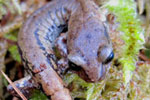
Hyloscirtus colymba tree frog being fed after being treated for Chytridiomycosis in Panama. Photo by: Rhett A. Butler.
The chytrid fungus, which is responsible for the collapse of numerous amphibian populations as well as the extinction of entire species, has been located for the first time in India, according to a paper in Herpetological Review. Researchers took swabs of frog in the genus Indirana in the Western Ghats and found the fungus, which leads to the killer disease chytridiomycosis.
“What we have detected is minimal, but it is very significant because this virus can threaten the already declining amphibian population in our forests to total extinction,” Sanil George with the Rajiv Gandhi Center for Biotechnology (RGCB) told The New Indian Express.
The chytridiomycosis disease is caused by a microscopic fungus called Batrachochytrium dendrobatidis (Bd) that lives in water and soil. The disease has decimated species throughout Central and South America, Africa, and Australia as it hinders the flow of sodium and other electrolytes across the frog’s skin, eventually resulting in heart failure.
Globally, the world’s amphibians are facing an extinction crisis. It’s believed that at least 120 amphibians have gone extinct in the last 30 years, while 41 percent of the world’s 7,000 known amphibians are considered threatened with extinction by the IUCN Red List. In addition to chytridiomycosis, deforestation, wetland loss, pollution, overexploitation, the pet trade, invasive species, and climate change have all taken a toll on these sensitive creatures, which have been dubbed by many ecologists as “canaries in a coal mine” for their ability to point out environmental degradation.
CITATIONS: Nair A., O. Daniel, S.V. Gopalan, S. George, K.S. Kumar, J. Merilä & A.G.F. Teacher. Infectious disease screening of Indirana frogs from the Western Ghats biodiversity hotspot. Herpetological Review 42: 554-557.
Related articles
Museum specimens reveal the tracks of an amphibian epidemic

(11/07/2011) Dead men tell no tales, but dead frogs can speak volumes. Scientists have shown that frogs and salamanders preserved in museums tell the history of a deadly fungus and its spread across Mexico and Central America. The new finding, published recently in the Proceedings of the National Academy of Sciences (PNAS), may help explain past and ongoing amphibian die-offs in the region.
Scientists find frog genes that provide immunity to extinction plague
(09/27/2011) Scientists with Cornell have discovered genetics that may provide immunity to frogs in face of the killer amphibian-disease chytridiomycosis. This plague, which is spreading to amphibian populations worldwide, is responsible for a number of frog species’ recent extinction. But now researchers report in a new study in the Proceedings of the National Academy of Sciences (PNAS) that they are one step closer to understanding why some frog populations are able to fend off the disease, while others succumb with lightning-speed. In time, the results may lead to breeding strategies in captivity that could produce immune populations.
Pictures: 12 new species of frog discovered in India
(09/15/2011) Scientists have discovered 12 new species of frogs in the rainforests of India’s Western Ghats, according to a paper published in the latest issue of ZooTaxa.